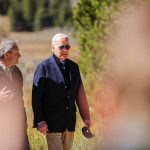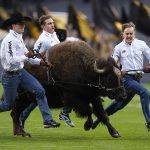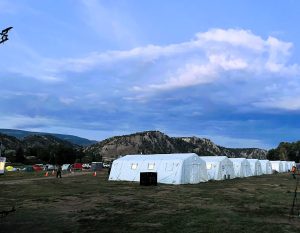Vail’s ski design revolutionary Howard Head inducted into National Inventors Hall of Fame

Colorado Ski and Snowboard Museum |
Editor’s Note: Howard Head’s quotes in this story by are taken from stories previously published by the Vail Daily, the Vail Trail, the Colorado Ski and Snowboard Museum Hall of Fame, Sports Illustrated (Sept. 29, 1980) and Airport Journal “A Bad Skier’s Revenge,” (Nov. 5, 2005).
VAIL — It was the winter of 1946 and Howard Head was riding a train with friends back to his home in Baltimore from Stowe, Vermont, where he had tried skiing for the first time. It did not go well.
Head was 6 feet 4 inches and a little gangly and was “humiliated and disgusted” at how badly he had skied. Head was also an aircraft engineer at the Glenn L. Martin Company. As he and his friends swapped stories about their weekend adventures, it occurred to Head that some of his skiing problems started with the skis — “those long, heavy, clumsy hickory skis,” he called them.
“If wood were the best material, they’d still be making airplanes out of wood,” Head said.
Head was an engineer and would engineer something better, he reasoned, something made from aircraft aluminum and plastic.

Support Local Journalism
It has been said that if Head were an omelet cook, then he’d redesign the egg.
It took Head three years and 40 failed attempts to create the skis that changed the sport.
“If I had known then that it would take 40 versions before the ski was any good, I might have given it up. But, fortunately, you get trapped into thinking the next design will be it,” Head recalled many years later.
For that, for his oversized tennis racket, and for so much more, Howard Head is among the 2017 class being inducted into The National Inventors Hall of Fame. The induction ceremony is May 3 and 4 in Washington.
“Howard was a gifted scientist. But he was more interested in science than he was in skiing. He could get down the hill, but he was not interested in skiing. He was interested in the skis,” said Morrie Shepherd, Vail’s first ski school director, and an early Head ski tester in Aspen and New Hampshire.
Not the write stuff
Head graduated from Harvard in 1936 with an engineering degree and failed as a writer and journalist for a few years — mostly because he spent more time fixing film splicers and machines than writing.
“I always wanted to be a newspaper writer,” he said. “I had no talent, but I wouldn’t admit it to myself.”
A Stevens Institute aptitude test determined he had the lowest potential for creative writing they had ever tested. His structural visualization score was the highest. That meant Head could think in three dimensions.
In 1939 he was hired as a riveter at the Glenn L. Martin Aircraft Company in Baltimore. When World War II broke out, Martin moved him to its engineering department where helped design the B-26 Marauder, a twin-engine bomber.
The B-26’s skin was an aluminum alloy sandwich wrapped around a honeycomb structure. Head’s Marauder was the first WWII aircraft to use plastic on a large scale.
And that leads us back to that 1946 train ride from Stowe to Baltimore.
The Head Ski Company
Head had about $6,000 stashed under his bed — “I was a pretty good poker player” — and rented a tiny space in an industrial area. He and three mechanics from Martin worked nights and weekends building skis. Not only did they build skis, they built the equipment to build the skis. Some of that equipment would have made Rube Goldberg proud.
They liberated some aluminum from the Martin scrap pile, and built six pairs of skis that first year. They were metal sandwiches — two layers of aluminum with plywood sidewalls around a plastic honeycomb core.
Head jumped in his car, raced to Stowe and convinced a half-dozen ski instructors to try them. All six pairs broke; one broke while an instructor was flexing before he put it on.
“Each time one of them broke, something inside me snapped with it,” Head said.
One of those Stowe instructors, Neil Robinson, told Head he was on to something and offered to keep testing Head’s creations. It was enough to keep Head going.
Vail and Aspen
Head started in Baltimore, but he was a Vail and Aspen guy.
Morrie Shepard was Vail’s first ski school director. In 1962 he followed Pete Seibert to Vail from Aspen, where Shepard had landed in the late 1940s.
Shepard grew up with Seibert in New England, and they first met Head in Tuckerman’s Ravine, New Hampshire in 1948, where Head was testing his new skis.
Seibert took a look at one of Head’s skis, turned it around in his hands and stuck an end in the snow to flex it, as he would the wooden skis he was using.
“Don’t!” Head shouted, “You’ll break it!” — something he had recent experience with in Stowe.
“You’ve done it, Mr. Head”
An Airport Journal story by Stuart Leuthner recounts one of Head’s trips to Aspen, where he met 10th Mountain Division veterans Clif Taylor and Steve Knowlton, both instructors with the Aspen Ski School. Head asked Taylor and Knowlton to try his skis. They agreed, rode the chairlift to the top of the mountain, and started their descent.
Taylor said he felt like he was floating in the powder. The skis went to crud right as the snow did lower down the mountain. Snow stuck to the base of the skis and they had to walk the rest of the way.
When an anxious Head rushed to ask what they thought. Knowlton nodded at the ski’s polished surface and said, “You see that outhouse over there? You can take these skis and nail them to the wall (as mirrors) and guys can use them when they shave! That’s all these skis are good for!”
Taylor was more diplomatic. He gave Head a few suggestions and offered to test future models.
After three years of abject failure, Head was down to his last shot. Taylor recalled that Head was living in a basement apartment for $20 a month, his crew had not been paid for a year and a half, and he was washing his dishes in his bathtub.
“I was out of money,” he said. “Either this ski was the right one, or I would simply have to close down the business and get a job.”
This was the spring of 1950 and Taylor was back at Tuckerman’s Ravine, with its pitch of 30 to 45 degrees. Head showed up with a couple pairs of skis on his shoulder, and asked Taylor to try them.
They worked, in every conceivable snow condition — early morning ice, afternoon crud — everything.
Taylor stopped in front of Head, showered him with snow, and exclaimed, “They’re great, Mr. Head. You’ve done it!”
Sheparding Head
Shepard is now 91, and has spent his life enjoying himself.
“Don’t cry for me when I’m gone,” Shepard said. “I’ve had more fun than anyone can imagine.”
There was the time in 1950 that Head sent Shepherd some 30 pair of skis to test. One pair had grooves sanded lengthwise into the aluminum base, because Head was curious to see what would happen.
“What happened was that I rode up Little Nell on a T-bar, turned around and went straight down the hill, through the parking lot, over a snowbank and across the road,” Shepherd said laughing.
Shepherd handed the skis to someone else, who did the same thing. So did eight other people.
Shepherd bought his first pair of Head skis in 1950, and skied on them until 1955.
Shepherd taught top Aspen ski school classes in those days.
“If you don’t have a pair of Head skis, there’s no way you can keep up with us,” he told his clients.
Head was relentless in enlisting ski instructors to help push his product. Some went so far as to hide behind trees or bushes when they saw him coming their way. Head correctly reasoned that clients would see his skis on those instructors, and would want his skis.
Many clients did. One Sun Valley, Idaho, instructor sold 30 pairs out of his bedroom. Eventually, even Knowlton was selling Head skis.
Head made Shepard a pro rep in Aspen. If anyone on the Aspen Skiing Company staff bought Head skis, then chances are they bought them from Shepard.
There’s an early Aspen ski school photo featuring 100 people and 99 pairs of Head skis, with one pair of wooden holds.
When Shepherd came to Vail with Seibert in 1962, he brought Head’s signature product with him. Head skis sold for $75 to $80, expensive in those days. Shepherd’s pro deal was $20 a pair.
Rod Slifer came from Aspen with Seibert and Shepard in 1962 to help build Vail, work as the assistant ski school director — and do everything all the time. Slifer brought his Head skis with him.
“They were really easy to ski, especially compared to wooden skis. It was a huge step,” Slifer said.
Wood skis were not flexible. The metal skis were, Slifer explained. They enabled even novice skiers to carve turns.
“When Howard discovered they were too soft for racing, he figured out a way to make them stiffer,” Slifer said.
By the end of the 1950s, more that 200,000 pairs of Head skis were in use. By 1955, Head skis were the leading brand in Europe and North America, and soon dominated competition, including the 1964 and 1968 Winter Olympics.
The Swiss were on Head skis in 1963. Other national ski teams quickly followed suit.
At the 1964 Olympics in Innsbruck, Austria, Steamboat’s Billy Kidd became the first American man to win an alpine skiing medal, a silver medal in the slalom. He did it on Head skis.
Tennis, anyone?
Head said his company outgrew his ability to manage it, so he sold it to AMF in 1969. Not long after, he took up tennis, and as a retired millionaire would, built a below-ground court. He spent thousand of dollars on lessons and thousands of hours practicing, trying to improve.
He didn’t.
He bought a Prince ball machine to practice with, redesigned it, bought part of the company and patented the improvements.
But still, his tennis did not improve.
One night he had an epiphany: Make the racket bigger. So he did. It took two years.
It’s physics, stuff Head knew about. He made his tennis racket was 20 percent wider than the old wooden rackets, one inch on each side. That makes the racket’s sweet spot 40 percent larger.
Head also substituted aluminum — and later graphite — for the wooden frame. Prince put it on the market in 1976. Within four years, more than 700,000 players were using it.
Head’s racket hit the big time when 16-year-old Pam Shriver used it to upset Martina Navratilova in the 1978 U.S. Open before losing to Chris Evert in the final.
Howard Head Sports Medicine
In the 1980s, Howard married Martha and settled in Vail, along with their other adventures. After he and Martha Fritzler were married, Howard lost a kidney and had to go on dialysis three times a week for three hours. It didn’t stop him. In 1987, he launched the Howard Head Sports Medicine Center and supported hundreds of causes.
Head was inducted into the Colorado Ski and Snowboard Museum Hall of Fame in 1990, the year before he died. He was 76.
Staff Writer Randy Wyrick can be reached at 970-748-2935 and rwyrick@vaildaily.com.











